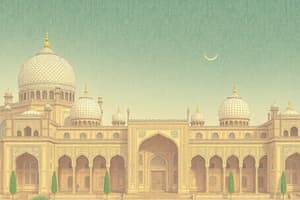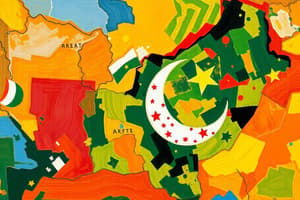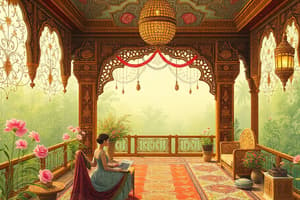Podcast
Questions and Answers
What is the Deccan Plateau?
What is the Deccan Plateau?
- A coastal plain in India
- A plateau in India formed by volcanic activity (correct)
- A mountain range in India
- A desert region in India
Which region in South Asia is landlocked?
Which region in South Asia is landlocked?
- Sri Lanka
- Pakistan
- Nepal and Bhutan (correct)
- India
What shaped the mountains and valleys in South Asia?
What shaped the mountains and valleys in South Asia?
- River erosion
- Glacier activity (correct)
- Tectonic plate movements
- Volcanic eruptions
Which body of water is to the west of South Asia?
Which body of water is to the west of South Asia?
What is the dominant climatic feature of South Asia?
What is the dominant climatic feature of South Asia?
What formed the submarine mountain range that became the Maldives?
What formed the submarine mountain range that became the Maldives?
Which river is not located in South Asia?
Which river is not located in South Asia?
What is the largest desert in India?
What is the largest desert in India?
Which country in South Asia is known for being an island?
Which country in South Asia is known for being an island?
What geographical feature characterizes the landscape of Maldives?
What geographical feature characterizes the landscape of Maldives?
Which mountain range is located in South Asia?
Which mountain range is located in South Asia?
What is the dominant source of water for the region of South Asia?
What is the dominant source of water for the region of South Asia?
Which empire was not a ruling power in India?
Which empire was not a ruling power in India?
Which South Asian country does not have a parliamentary democracy?
Which South Asian country does not have a parliamentary democracy?
Which sport is not popular in South Asia?
Which sport is not popular in South Asia?
What is the dominant type of economy in South Asia?
What is the dominant type of economy in South Asia?
Which environmental issue is not a challenge in South Asia?
Which environmental issue is not a challenge in South Asia?
Which ethnic group is not mentioned as a significant population in South Asia?
Which ethnic group is not mentioned as a significant population in South Asia?
What is the staple meat in South Asian cuisine?
What is the staple meat in South Asian cuisine?
Which country in South Asia has made significant improvements in private education?
Which country in South Asia has made significant improvements in private education?
Which religion is not prevalent in South Asia?
Which religion is not prevalent in South Asia?
Which empire did Mahatma Gandhi lead passive resistance against?
Which empire did Mahatma Gandhi lead passive resistance against?
What is the traditional family structure in South Asian nations?
What is the traditional family structure in South Asian nations?
What is the dominant language family in South Asia?
What is the dominant language family in South Asia?
Which country in South Asia has a federal parliamentary republic?
Which country in South Asia has a federal parliamentary republic?
Which empire was Mahatma Gandhi known for leading passive resistance against?
Which empire was Mahatma Gandhi known for leading passive resistance against?
Which of the following is a key term associated with South Asia's geography?
Which of the following is a key term associated with South Asia's geography?
Which of the following is a staple food in South Asia?
Which of the following is a staple food in South Asia?
Which sport is popular in South Asia?
Which sport is popular in South Asia?
Which ethnic group is NOT mentioned as part of the diverse population in South Asia?
Which ethnic group is NOT mentioned as part of the diverse population in South Asia?
What type of government do most countries in South Asia have?
What type of government do most countries in South Asia have?
What is the predominant religion in South Asia?
What is the predominant religion in South Asia?
What is a key challenge facing South Asia?
What is a key challenge facing South Asia?
Which term is associated with the Hindu tradition in South Asia?
Which term is associated with the Hindu tradition in South Asia?
What has India made significant improvements in?
What has India made significant improvements in?
Which resource is NOT mentioned as part of South Asia's resources?
Which resource is NOT mentioned as part of South Asia's resources?
India has only been ruled by the Mauryan, Gupta, Mughal, and British Empires throughout its history.
India has only been ruled by the Mauryan, Gupta, Mughal, and British Empires throughout its history.
All countries in South Asia have parliamentary democracies.
All countries in South Asia have parliamentary democracies.
Healthcare in South Asia is universally accessible.
Healthcare in South Asia is universally accessible.
The majority of the population in South Asia is of Indo-Aryan descent.
The majority of the population in South Asia is of Indo-Aryan descent.
Badminton is not a popular sport in South Asia.
Badminton is not a popular sport in South Asia.
The extended family has not been the building block of South Asian nations.
The extended family has not been the building block of South Asian nations.
Hindu tradition does not assign people to different castes.
Hindu tradition does not assign people to different castes.
South Asian countries do not have sustainable birth rates.
South Asian countries do not have sustainable birth rates.
South Asia is not classified as a subcontinent
South Asia is not classified as a subcontinent
The Deccan Plateau resulted from extensive volcanic activity
The Deccan Plateau resulted from extensive volcanic activity
The Maldives were formed by tectonic activity
The Maldives were formed by tectonic activity
South Asia experiences cold temperatures due to its location
South Asia experiences cold temperatures due to its location
South Asia has the strongest monsoon winds in the world
South Asia has the strongest monsoon winds in the world
The Karakoram Mountains are not located in South Asia
The Karakoram Mountains are not located in South Asia
The Arabian Sea is the only body of water to the west of South Asia
The Arabian Sea is the only body of water to the west of South Asia
Flashcards are hidden until you start studying
Study Notes
South Asia: Geography, History, Government, Education, Economy, Demographics, Culture, Religion, Family, and Environmental Challenges
- South Asia's resources include petroleum, natural gas, uranium, coal, gemstones, copper, iron ore, timber, limestone, and fish.
- India was successively ruled by the Mauryan Empire, Gupta Empire, Mughal Empire, and the British Empire, with Mahatma Gandhi leading passive resistance against the British.
- The countries in South Asia, except Nepal, have parliamentary democracies, while Nepal has a federal parliamentary republic.
- India has made significant improvements in its educational system, and private education is on the rise, while healthcare varies from universal to minimal in South Asia.
- The economies in South Asia are a mix of agriculture, industry, textiles, and tourism, with different countries having mixed or free-market economies.
- South Asian countries have sustainable birth rates, and the majority of the population is of Indo-Aryan descent, with diverse ethnic groups including Punjab, Pashtun, Bengali, and Sinhalese.
- South Asia has a rich diversity of languages, cultures, and traditions, celebrated through music, dance, and ethnic foods.
- Staple foods in South Asia include rice, vegetables, and chicken, with popular sports including badminton, soccer, volleyball, and cricket.
- The extended family has been the building block of South Asian nations, and Hindu tradition assigns people to different castes, with the concept of "untouchables" and the belief in reincarnation and moksha.
- Challenges in South Asia include mistreatment of women, child brides, human trafficking, and environmental issues such as air and water pollution, deforestation, and waste management.
- Proposed solutions for environmental issues include disciplined recycling, cleaner energy development, reforestation, and reporting of illegal dumping.
- Key terms to know include subcontinent, Deccan Plateau, monsoon, Mauryan Empire, Mughal Empire, passive resistance, caste, untouchables, reincarnation.
South Asia: Geography, History, Government, Education, Economy, Demographics, Culture, Religion, Family, and Environmental Challenges
- South Asia's resources include petroleum, natural gas, uranium, coal, gemstones, copper, iron ore, timber, limestone, and fish.
- India was successively ruled by the Mauryan Empire, Gupta Empire, Mughal Empire, and the British Empire, with Mahatma Gandhi leading passive resistance against the British.
- The countries in South Asia, except Nepal, have parliamentary democracies, while Nepal has a federal parliamentary republic.
- India has made significant improvements in its educational system, and private education is on the rise, while healthcare varies from universal to minimal in South Asia.
- The economies in South Asia are a mix of agriculture, industry, textiles, and tourism, with different countries having mixed or free-market economies.
- South Asian countries have sustainable birth rates, and the majority of the population is of Indo-Aryan descent, with diverse ethnic groups including Punjab, Pashtun, Bengali, and Sinhalese.
- South Asia has a rich diversity of languages, cultures, and traditions, celebrated through music, dance, and ethnic foods.
- Staple foods in South Asia include rice, vegetables, and chicken, with popular sports including badminton, soccer, volleyball, and cricket.
- The extended family has been the building block of South Asian nations, and Hindu tradition assigns people to different castes, with the concept of "untouchables" and the belief in reincarnation and moksha.
- Challenges in South Asia include mistreatment of women, child brides, human trafficking, and environmental issues such as air and water pollution, deforestation, and waste management.
- Proposed solutions for environmental issues include disciplined recycling, cleaner energy development, reforestation, and reporting of illegal dumping.
- Key terms to know include subcontinent, Deccan Plateau, monsoon, Mauryan Empire, Mughal Empire, passive resistance, caste, untouchables, reincarnation.
Studying That Suits You
Use AI to generate personalized quizzes and flashcards to suit your learning preferences.




